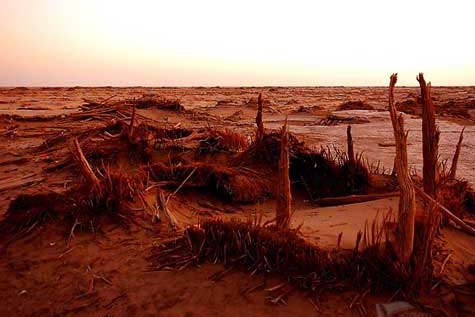Home > Attractions >
The Ruins of Ancient Haitou City
Located in the northeastern Ruoqiang County, the Haitou City was the second largest one in Lop Nor area in the Wei and Jin times, next only to Loulan City, with a circumference of 590 meters. The city has a barbican entrance in the gate. After the abandonment of the Loulan City in the 4th century A.D., the Haitou City became the Zhangshi of the western countries. Some scholars concluded that the so-called “Libo Document” was unearthed here. The document wrote: “Now (I)am ordered to come westwards, and arrived here on 2 this month”, among them the word “Here” was marked with a circle and noted to the side of it with two words “Hai Tou”. Another document wrote: “ (I )arrived at Hai Tou on 2 this month”. Therefore, they concluded that the city, which was marked as LK by M. Aurel Stein, should be the “Haitou City”.
Lop Nor called “Youze Lake”, “Salt Lake”, and “Puchang Sea” in ancient times. In Mongolian, “Lop Nor” means “The Lake Converging Many Water Sources”. Lop Nor is located at the eastern end of the Tarim Basin in the northeast part of Ruoqiang County. It is a terminal lake of Tarim River, occupying an area of over 3,000 square kilometers, the biggest salt migration lake in our country. Now it is dried-up completely and the lakebed is covered by hard salt crust, and in vicinity of it are marvelous Yardang spectacles. Strategically located on the southern route of the ancient Silk Road, Lop Nor occupied a point must pass through before coming into the Western Regions in ancient times, so it is provided with important strategic significance. A great lot of historical remains have been found along the banks of lake up to now. Among them is the well-known the Loulan Site, which is situated on the western bank of it.
Lop Nor called “Youze Lake”, “Salt Lake”, and “Puchang Sea” in ancient times. In Mongolian, “Lop Nor” means “The Lake Converging Many Water Sources”. Lop Nor is located at the eastern end of the Tarim Basin in the northeast part of Ruoqiang County. It is a terminal lake of Tarim River, occupying an area of over 3,000 square kilometers, the biggest salt migration lake in our country. Now it is dried-up completely and the lakebed is covered by hard salt crust, and in vicinity of it are marvelous Yardang spectacles. Strategically located on the southern route of the ancient Silk Road, Lop Nor occupied a point must pass through before coming into the Western Regions in ancient times, so it is provided with important strategic significance. A great lot of historical remains have been found along the banks of lake up to now. Among them is the well-known the Loulan Site, which is situated on the western bank of it.





